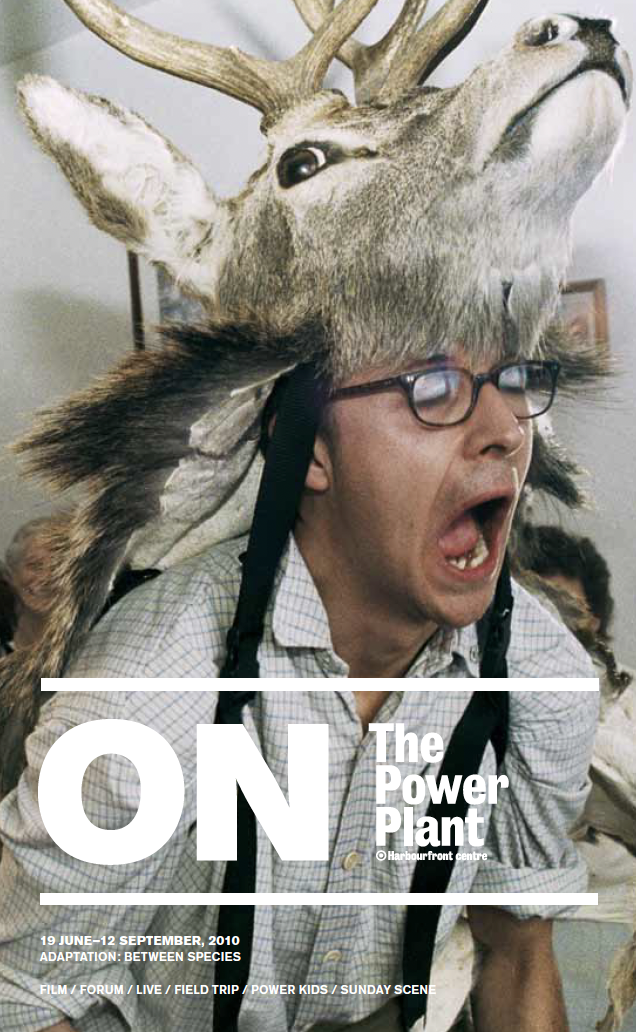Adaptation: Between Species
Various Artists
Past Exhibition
Jun 18 – Sep 11 2010
Marcus Coates, Journey to the Lower World, 2004. Single-channel video, 30 min. Courtesy the artist and Kate MacGarry, London.
- Support Donor
The Jack Weinbaum Family Foundation
- CURATOR
Helena Reckitt
Responding to the contemporary desire to go "back to nature," The Power Plant’s summer group exhibition Adaptation: Between Species highlights interspecies encounters. What happens when humans, animals and the natural world meet? What forms of communication, miscommunication, intimacy and exchange ensue?
As the industrialized world further encroaches on the natural world, species live in ever-closer proximity. Yet many people feel profoundly cut off from natural environments and from their own animal natures. Our deep longing to connect with non-human life forms is reflected in contemporary phenomena ranging from the boom in pet ownership and the widespread anthropomorphism in popular culture to the upsurge in vacations that promise to transport us to unspoiled lands.
Yet despite this deep-seated human sense of alienation from nature, all animal species are in fact closely related. For instance, as Donna Haraway notes in her book When Species Meet, 90 percent of human cells are filled with the genomes of bacteria, fungi, protists, and such, with only 10 percent comprising human genomes. Adaptation explores this commonality between the species and considers the various forms of intelligence and knowledge they share. It also asks what our interactions with other species reveal about our human and animal natures. Highlighting the urge to observe, touch, live with, and mimic other species, the exhibition delves into the intimate and, at times, uncanny fusions that result. From another perspective, Adaptation looks at the facility that animals have in adapting to our domestic and urban environments, including the ability to "train" their masters.
Coinciding with the United Nations International Year of Biodiversity, the exhibition considers how adaptation functions as a form of biological and cultural survival. Adaptation also builds on Roger Caillois’s 1935 essay “Mimicry and Legendary Psychasthenia” – which was central to Surrealist thought as well as to Jacques Lacan’s theories of the Mirror Stage – to think through the spatial, aesthetic and psychological nuances of camouflage and assimilation. However, Adaptation also takes a realistic view of human/non-human dynamics: it acknowledges the unbalanced and exploitative power relations that too often characterize our society’s attitudes toward other life forms.
This focus on the interface between humans and other species builds on a rich body of critical work that is emerging in various disciplines, from policy and law, philosophy, anthropology, science, and cultural studies to animal rights and environmental activism. Influential studies include Giorgio Agamben’s The Open: Man and Animal, Jacques Derrida’s The Animal That Therefore I Am, Gilles Deleuze’s The Body, the Meat and the Spirit: Becoming Animal, Richard Dawkins’s The Greatest Show on Earth: The Evidence for Evolution, and Donna Haraway’s impressive oeuvre on human/animal relations. Academic institutions are also addressing similar questions. In Ontario alone, a recent studio art class at the University of Guelph explored the phenomenon of "cultural followers" – animals that thrive within human environments – and in 2009 the Ontario College of Art & Design launched a module on Biomimicry & Design.
Adaptation: Between Species presents the work of leading international artists alongside that of newer figures whose work has gained international attention. Ranging in tone from reverent to decidedly iconoclastic, and created with media including photography, film and video, sculpture, and painting, works in the exhibition examine the lure of primeval states and primitive behaviours, and the urge to understand oneself as wild at heart.
SUMMER 2010 PROGRAM GUIDE

Marcus Coates, Journey to the Lower World, 2004. Single-channel video, 30 min. Courtesy the artist and Kate MacGarry, London.
Shaun Gladwell, Apologies 1–6, 2007–09. Video, 27:10 min. Courtesy the artist, Anna Schwartz Gallery (Sydney) and Georgia Scherman Projects (Toronto). Photo: Steve Payne.
Adaptation: Between Species with work by FASTWÜRMS. Photo: Steve Payne.
Adaptation: Between Species with work by Olaf Breuning, Mark Dion and Sandra Meigs. Photo: Steve Payne.
Francis Alÿs, The Nightwatch, 2004. Video documentation of an action, National Portrait Gallery, London, 17:30 min. Collection of Jay Smith and Laura Rapp. Courtesy the artist, Galerie Peter Kilchmann (Zurich) and David Zwirner (New York).
John Bock, Gast, 2004. Video, 12 min. Courtesy the artist, Anton Kern (New York), Klosterfelde (Berlin), and Sadie Coles HQ (London). Photo: Steve Payne.
About the Artists
Allora & Calzadilla
Allora & Calzadilla is a partnership of Jennifer Allora and Guillermo Calzadilla. They have produced a wide-ranging body of work across sculpture, photography, performance art, sound and video.
Francis Alÿs
Francis Alÿs is a Belgian artist, born in 1959, in Antwerp. He is currently based in Mexico.
Olaf Breuning
Olaf Breuning (born in Schaffhausen, 1970) employs everyday objects to create drawings, sculptures, films, installations, and photographs inspired by media, mass culture and the Internet.